Hardware Implementation of Novel Shade Dispersion PV Reconfiguration Technique to Enhance Maximum Power under Partial Shading Conditions
Abstract
:1. Introduction
- Sudoku is limited to a 9 × 9 array and has different logic patterns. Calculating a higher-order magic matrix is very difficult in the magic square method. Square puzzle patterns may require more computational burden, complex wiring, and losses; puzzle-based methods such as the skyscraper have clue dependency, and clue choosing is tedious. This study proposes a new method of static reconfiguration to address these issues;
- The proposed novel shade dispersion (NSD) method is a two-step method. In the first step, a magical submatrix is formed, and in the second step, logical shifting is performed to distribute the shade and increase the power generation of the PV array. This method considers magic sub-matrix shifting to reposition the panels in the same column, maintaining the least possible wiring;
- The proposed scheme was analyzed under ten shading cases. The results validated with SP, TCT, BL, and HC compared the global maximum power point (GMPP), mislead power (MP), output power (%O/P), efficiency, fill factor, and % power enhancement for NSD under-considered shading pattern. Figure 1 gives the workflow of this paper.
2. Modeling and Simulation of NSD Method
- The submatrix is proposed so that rows and column multiplication of the submatrix is 6;
- Therefore, numbers 1 to 6 are placed in the 2 × 3 submatrix to summation equal to the magic number 21;
- 3.
- The submatrix placing is started in the 1st row, 1st column position. The next submatrix is placed at the next (3rd) row, next (2nd) column position. This process continues until the last (6th) row is filled by the considered submatrix;
- 4.
- Submatrix rows are interchanged, and that submatrix starts to fill in vacant places of the primary matrix, starting from the next column of previously filled areas. Here, the interchanged submatrix is filled from 1st row, 4th column. The next submatrix is placed in the 3rd row and 4th column. The last column of the submatrix is placed in the same row and vacant column serially;
- 5.
- It is performed so that the summation of row numbers, as well as column numbers, is equal to the magic number 21, as shown in Figure 3b;
- 6.
- The process continues until vacant places in the primary matrix are filled, and the fifth step is achieved.
3. Partial Shadings Conditions and Shade Dispersion Effect
- Case II to case IV have group 1 of 24 panels with 1000 W irradiance; groups 2, 3, and 4 have 200 W, 500 W, and 700 W irradiance, respectively, with four panels in each group;
- In case V, 10 modules have PSCs, group 1 with 1000 W has 26 panels. Group 2, with 200 W, has four modules, and groups 3 and 4 have 500 W, 700 W irradiance, respectively, with three panels;
- Case VI has groups 1, 2, 3, and 4 with 1000 W, 200 W, 500 W, and 700 W irradiance on 28, 3, 1, and 4 modules, respectively;
- In case VII, 24 panels came in group 1. Groups 2 and 3, have 200 W and 700 W irradiance, respectively. Group 4 has two panels that have 700 W irradiance;
- In case VIII, groups 1, 2, 3, and 4 have five panels in each group of 1000 W, 200 W, 500 W, and 700 W irradiance with 16, 8, 7, and five panels, respectively;
- In case IX, only five modules are partially shaded, and 31 modules have 1000 W irradiance in group 1. It has two 200 W modules in group 2, one 500 W module in group 3 and two 700 W irradiance panels in group 4;
- In case X, with 1000 W, group 1 has 25 panels. Group 2, with 200 W has four panels, and groups 3 and 4 have 500 W and 700 W irradiance, respectively, with three panels.
4. Result and Discussion
4.1. Power-Voltage Profiles under Various PSC
4.2. Computational Parameters
4.2.1. Global Maximum Power Point (GMPP)
4.2.2. Mislead Power (MP)
4.2.3. Percent Output (%O/P)
4.2.4. Efficiency (η)−
4.2.5. Fill Factor (FF)−
4.2.6. Percent Power Enhancement (%PE)

5. Experimental Implementation and Result Analysis
5.1. Experimental Setup
5.2. Experimental Result Analysis
5.2.1. PSC Case I
5.2.2. PSC Case II
6. Conclusions
- In partial shading cases, for the least irradiating case VIII and most irradiating case IX, NSD has maximum power extraction of 5160 W and 6952.8 W, respectively; the highest efficiency of 20.97% and 20.87%, respectively; FF is 0.6976 and 0.6803, respectively; and the lowest ML of 2505.6 W and 713 W among all configurations, respectively;
- Under PSC for the considered PV array, TCT has the highest GMPP, %O/P, efficiency, FF, %PE, and least %MP at 5683 W, 74%, 18.54%, 0.5784, and 28.73%. Compared with TCT, NSD has 705.77 W, 9.2%, and 0.1139 enhancement in GMPP, %O/P, and FF, and a 2.41% reduction in MP;
- The results obtained from the first simulation show that the NSD method achieved the most significant output power and overall performance compared with all conventional configurations under nine partial shading cases;
- Moreover, experimental research was carried out. The suggested NSD PV array reconfiguration design beats the other conventional PV array configurations (SP, BL, HC, and TCT) in power increase and several peaks. The experimental setup validated the influence of panel shifting on various PV array topologies.
Author Contributions
Funding
Institutional Review Board Statement
Informed Consent Statement
Data Availability Statement
Conflicts of Interest
Appendix A
| Symbol | Electrical Characteristics | Ratings |
|---|---|---|
| Pmax | Maximum power | 231.15 W |
| Voc | Open circuit voltage | 36.3 V |
| Isc | Short circuit current | 7.84 A |
| Imax | Maximum power point current | 7.35 A |
| Vmax | Maximum power point voltage | 29 V |
| - | Temperature coefficient of Voc | −0.3609%/deg. °C |
| - | Temperature coefficient of Isc | 0.102%/deg. °C |
Appendix B
- Global Maximum Power Point (GMPP): GMPP is the single maximum point on the PV curve.
- Mislead Power (MP): MP denotes the difference between GMPP in the non-shading (NS) condition and GMPP in the shaded (PSC). It creates the hot spot effect and, due to that, power loss. It is provided by:
- Percent Output (%O/P): The %O/P is calculated as the maximum power ratio under PSC to extreme power under non-shading (NS) conditions. It provides how much energy is generated under PSC compared with power at standard irradiance. It reaches the %O/P of the PV array under PSC and NS conditions. It provides how much percentage of PSC affects the PV array output.
- Efficiency (η): It is provided by the ratio output power (power generation) POut to input power (solar insolation) Pin On the PV panel. It is provided by:
- Fill Factor (FF): The maximum power generated at PSC to the total rated capacity of a solar PV array is FF. It is also known as the usefulness of PV array. It is always 0 to 1. It is provided by:
- Percent Power Enhancement (%PE): %PE is provided by the difference between the GMPP for the proposed NSD method and the GMPP for conventional configuration (CC) under partial shading conditions. It provides how much power is enhanced by NSD compared with CC under various irradiance conditions.
References
- Sahoo, S.K. Renewable and sustainable energy reviews solar photovoltaic energy progress in India: A review. Renew. Sustain. Energy Rev. 2016, 59, 927–939. [Google Scholar] [CrossRef]
- Fouad, M.M.; Shihata, L.A.; Morgan, E.S.I. An integrated review of factors influencing the performance of photovoltaic panels. Renew. Sustain. Energy Rev. 2017, 80, 1499–1511. [Google Scholar] [CrossRef]
- Venkateswari, R.; Sreejith, S. Factors influencing the efficiency of photovoltaic system. Renew. Sustain. Energy Rev. 2019, 101, 376–394. [Google Scholar] [CrossRef]
- Attivissimo, F.; Di Nisio, A.; Savino, M.; Spadavecchia, M. Uncertainty analysis in photovoltaic cell parameter estimation. IEEE Trans. Instrum. Meas. 2012, 61, 1334–1342. [Google Scholar] [CrossRef]
- Hysa, A. Modeling and Simulation of the Photovoltaic Cells for Different Values of Physical and Environmental Parameters. Emerg. Sci. J. 2019, 3, 395–406. [Google Scholar] [CrossRef] [Green Version]
- Praveen Kumar, B.; Prince Winston, D.; Cynthia Christabel, S.; Venkatanarayanan, S. Implementation of a switched PV technique for rooftop 2 kW solar PV to enhance power during unavoidable partial shading conditions. J. Power Electron. 2017, 17, 1600–1610. [Google Scholar] [CrossRef]
- Ziar, H.; Nouri, M.; Asaei, B.; Farhangi, S. Analysis of overcurrent occurrence in photovoltaic modules with overlapped by-pass diodes at partial shading. IEEE J. Photovolt. 2014, 4, 713–721. [Google Scholar] [CrossRef]
- Mäki, A.; Valkealahti, S. Power losses in long string and parallel-connected short strings of series-connected silicon-based photovoltaic modules due to partial shading conditions. IEEE Trans. Energy Convers. 2012, 27, 173–183. [Google Scholar] [CrossRef]
- Hussan, R.; Sarwar, A. Maximum power point tracking techniques under partial shading condition-A review. In Proceedings of the 2018 2nd IEEE International Conference on Power Electronics, Intelligent Control and Energy Systems, New Delhi, India, 22–24 October 2018; pp. 293–298. [Google Scholar] [CrossRef]
- Bana, S.; Saini, R.P. Experimental investigation on power output of different photovoltaic array configurations under uniform and partial shading scenarios. Energy 2017, 127, 438–453. [Google Scholar] [CrossRef]
- Pendem, S.R.; Mikkili, S. Modelling and performance assessment of PV array topologies under partial shading conditions to mitigate the mismatching power losses. Sol. Energy 2018, 160, 303–321. [Google Scholar] [CrossRef]
- Bingöl, O.; Özkaya, B. Analysis and comparison of di ff erent PV array con fi gurations under partial shading conditions. Sol. Energy 2018, 160, 336–343. [Google Scholar] [CrossRef]
- Raju, V.B.; Chengaiah, C. Power Enhancement of Solar PV Arrays under Partial Shading Conditions with Reconfiguration Methods. In Proceedings of the 2019 Innovations in Power and Advanced Computing Technologies (i-PACT), Vellore, India, 22–23 March 2019; pp. 1–7. [Google Scholar] [CrossRef]
- Ajmal, A.M.; Sudhakar Babu, T.; Ramachandaramurthy, V.K.; Yousri, D.; Ekanayake, J.B. Static and dynamic reconfiguration approaches for mitigation of partial shading influence in photovoltaic arrays. Sustain. Energy Technol. Assess. 2020, 40, 100738. [Google Scholar] [CrossRef]
- Manjunath, M.; Reddy, B.V.; Lehman, B. Performance improvement of dynamic PV array under partial shade conditions using M2 algorithm. IET Renew. Power Gener. 2019, 13, 1239–1249. [Google Scholar] [CrossRef]
- Varma Gadiraju, H.K.; Reddy Barry, V.; Maraka, I. Dynamic Photovoltaic Array Reconfiguration for Standalone PV Water Pumping System. In Proceedings of the 2019 8th International Conference on Power Systems: Transition towards Sustainable, Smart and Flexible Grids (ICPS), Jaipur, India, 20–22 December 2019; IEEE: Piscataway, NJ, USA, 2019; pp. 29–32. [Google Scholar] [CrossRef]
- Bularka, S.; Gontean, A. Dynamic PV array reconfiguration under suboptimal conditions in hybrid solar energy harvesting systems. In Proceedings of the 2017 IEEE 23rd International Symposium for Design and Technology in Electronic Packaging, Constanta, Romania, 26–29 October 2017; pp. 419–422. [Google Scholar] [CrossRef]
- Pachauri, R.K.; Alhelou, H.H.; Bai, J.; Golshan, M.E.H. Adaptive Switch Matrix for PV Module Connections to Avoid Permanent Cross-Tied Link in PV Array System under Non-Uniform Irradiations. IEEE Access 2021, 9, 45978–45992. [Google Scholar] [CrossRef]
- Rani, B.I.; Ilango, G.S.; Nagamani, C. Enhanced power generation from PV array under partial shading conditions by shade dispersion using Su Do Ku configuration. IEEE Trans. Sustain. Energy 2013, 4, 594–601. [Google Scholar] [CrossRef]
- Sai Krishna, G.; Moger, T. Improved SuDoKu reconfiguration technique for total-cross-tied PV array to enhance maximum power under partial shading conditions. Renew. Sustain. Energy Rev. 2019, 109, 333–348. [Google Scholar] [CrossRef]
- Sreekantha Reddy, S.; Yammani, C. A novel Magic-Square puzzle based one-time PV reconfiguration technique to mitigate mismatch power loss under various partial shading conditions. Optik 2020, 222, 165289. [Google Scholar] [CrossRef]
- Vijayalekshmy, S.; Bindu, G.R.; Rama Iyer, S. Performance comparison of Zig-Zag and Su do Ku schemes in a partially shaded photo voltaic array under static shadow conditions. In Proceedings of the 2017 Innovations in Power and Advanced Computing Technologies (i-PACT), Vellore, India, 21–22 April 2017; pp. 1–6. [Google Scholar] [CrossRef]
- Dhanalakshmi, B.; Rajasekar, N. A novel Competence Square based PV array reconfiguration technique for solar PV maximum power extraction. Energy Convers. Manag. 2018, 174, 897–912. [Google Scholar] [CrossRef]
- Nihanth, M.S.S.; Ram, J.P.; Pillai, D.S.; Ghias, A.M.Y.M.; Garg, A.; Rajasekar, N. Enhanced power production in PV arrays using a new skyscraper puzzle based one-time reconfiguration procedure under partial shade conditions (PSCs). Sol. Energy 2019, 194, 209–224. [Google Scholar] [CrossRef]
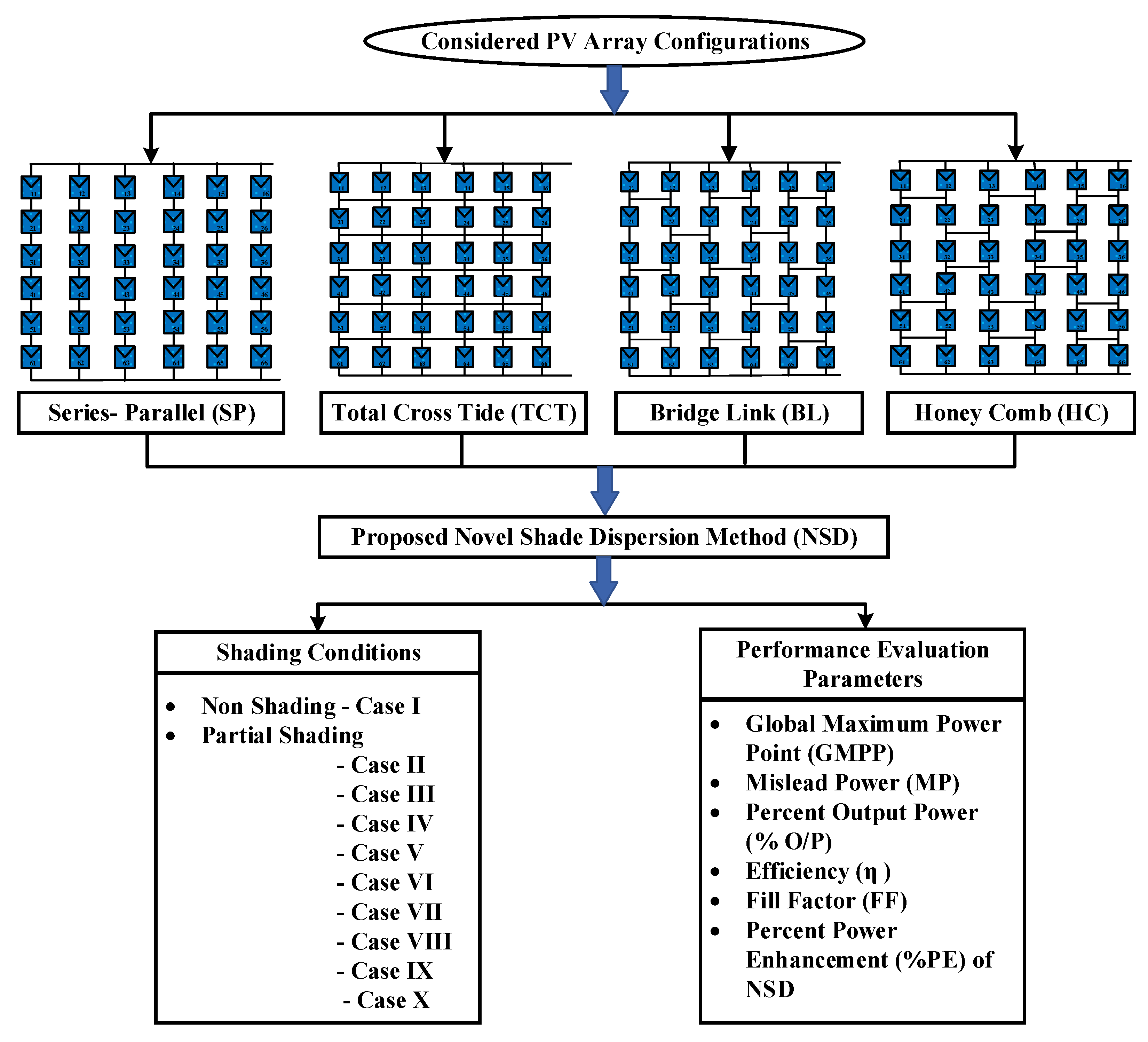
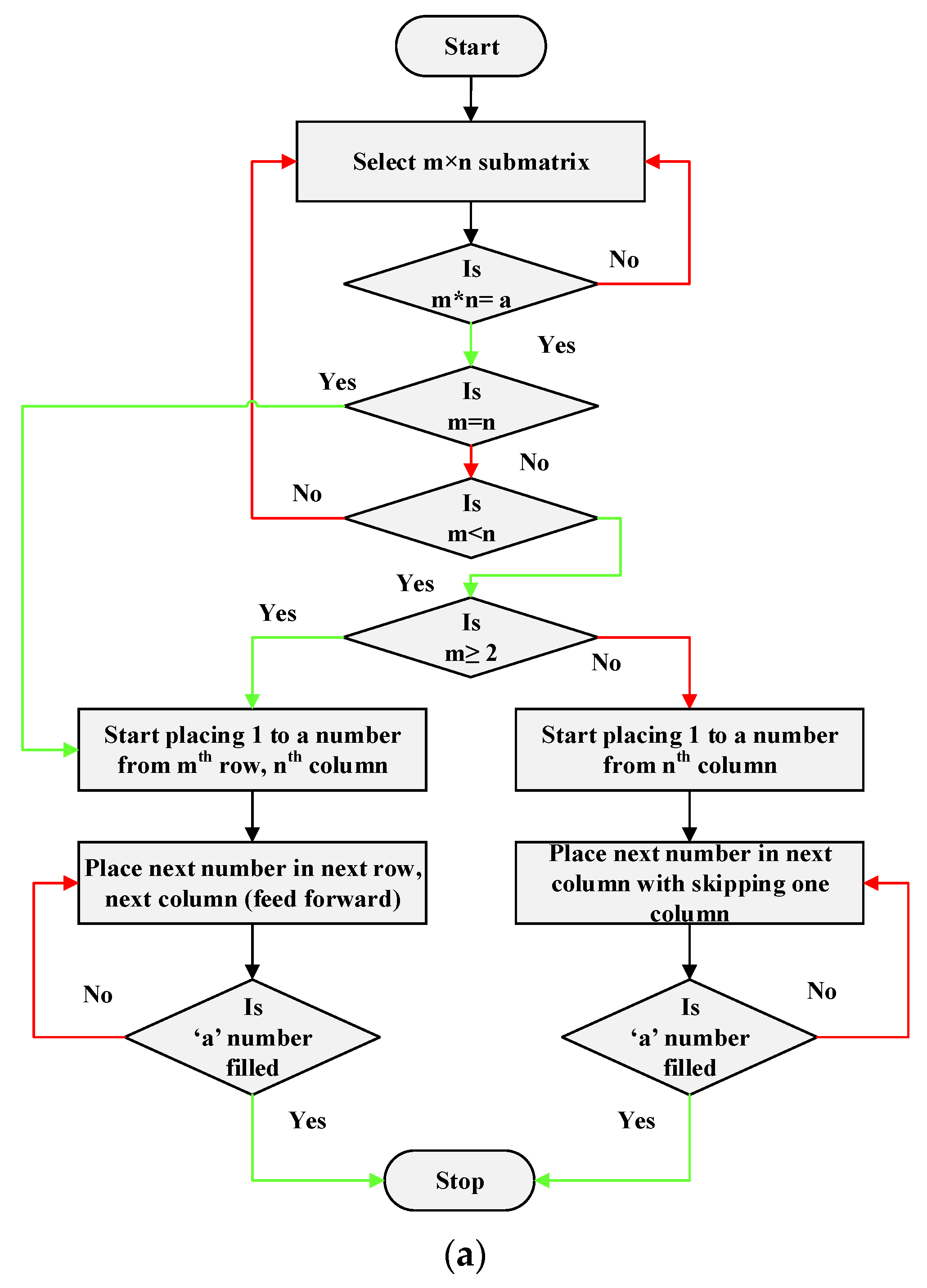
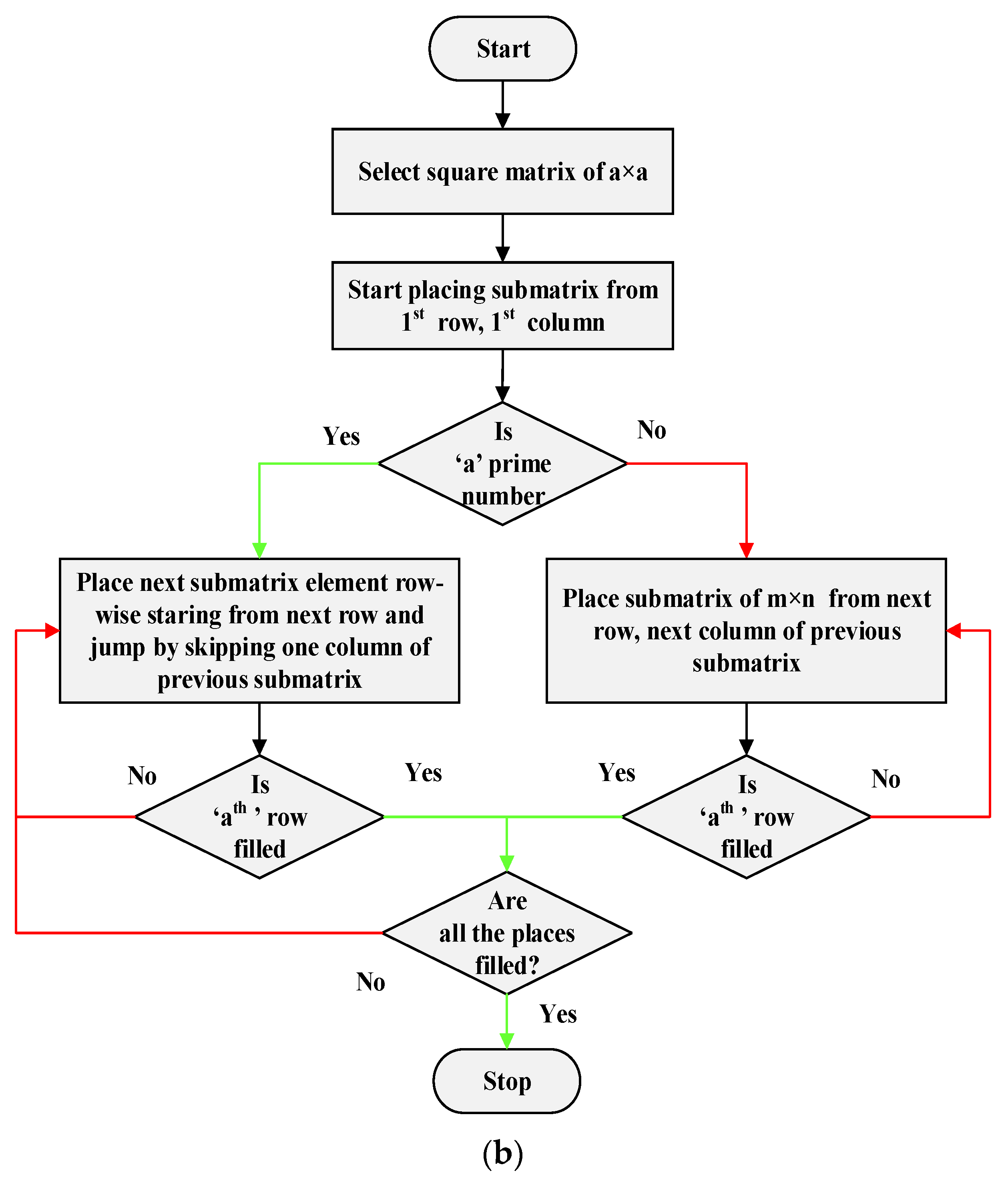
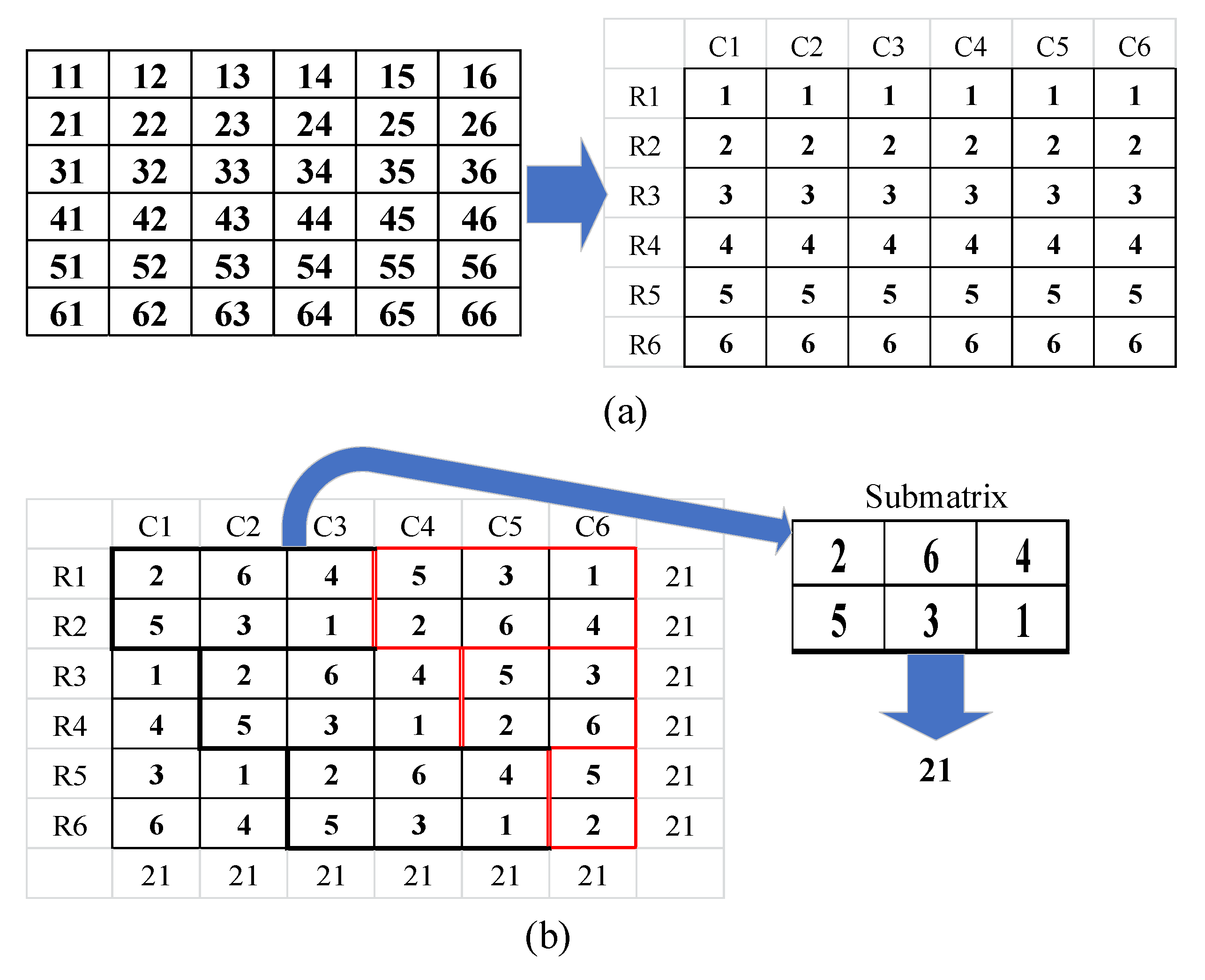

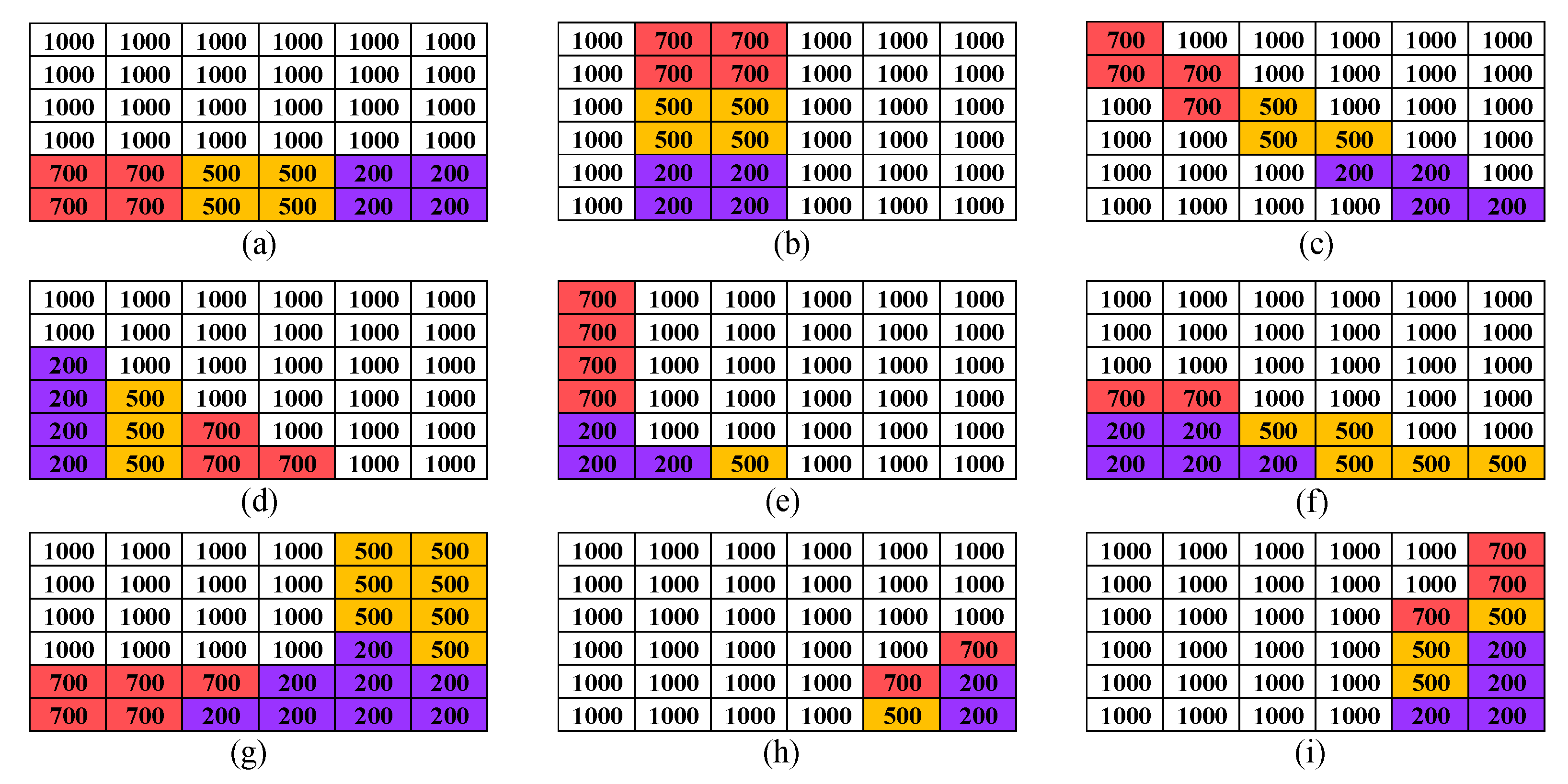
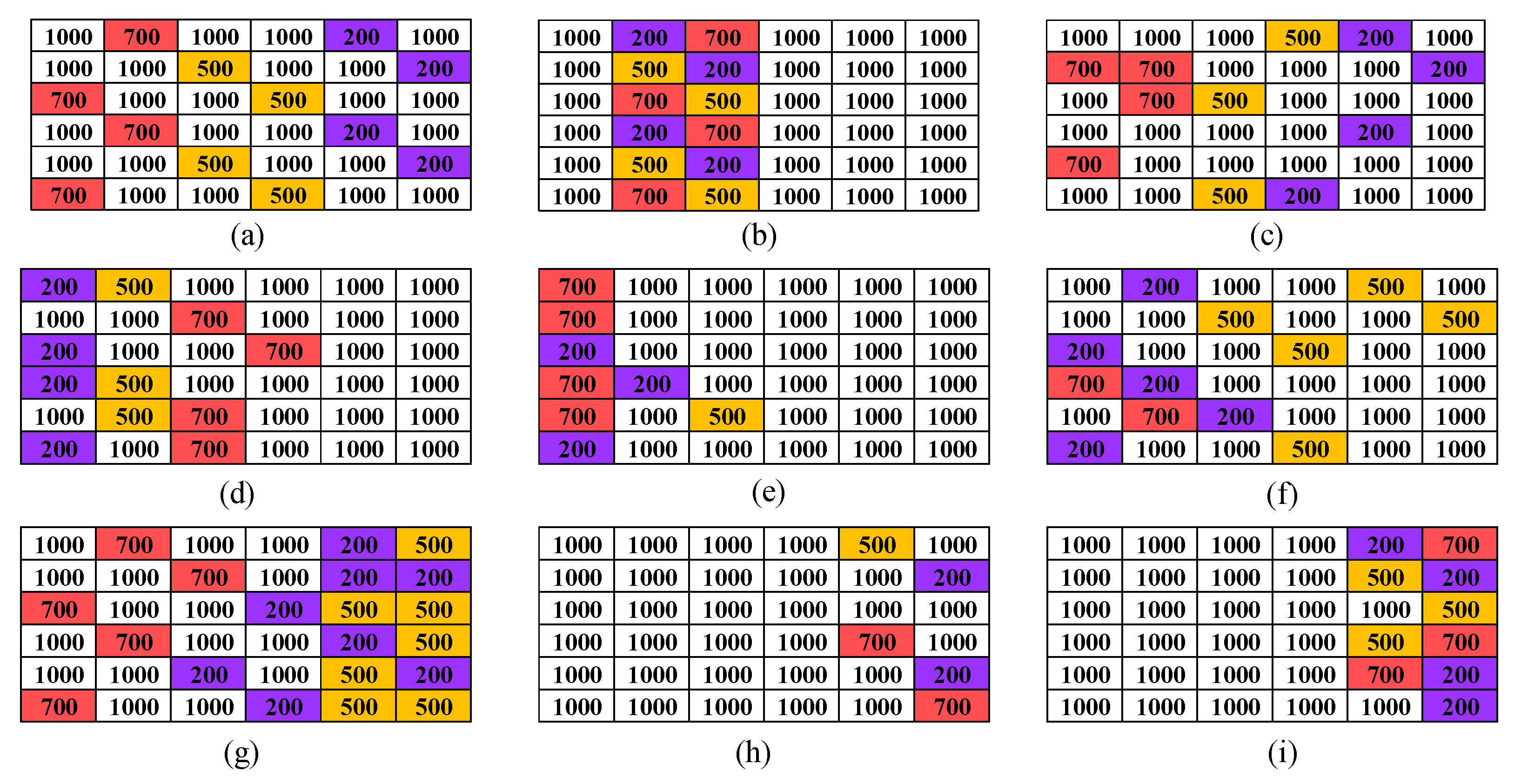

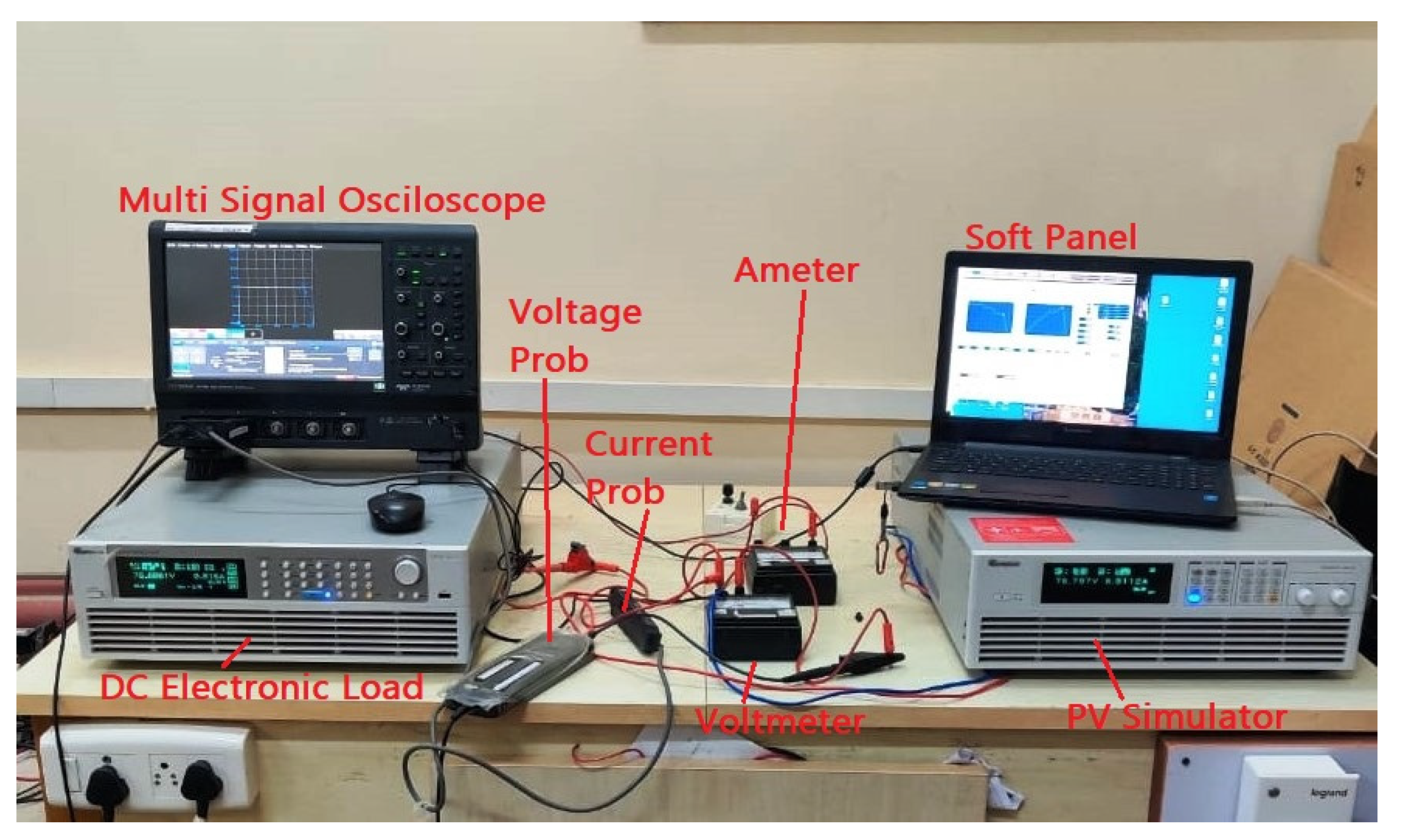


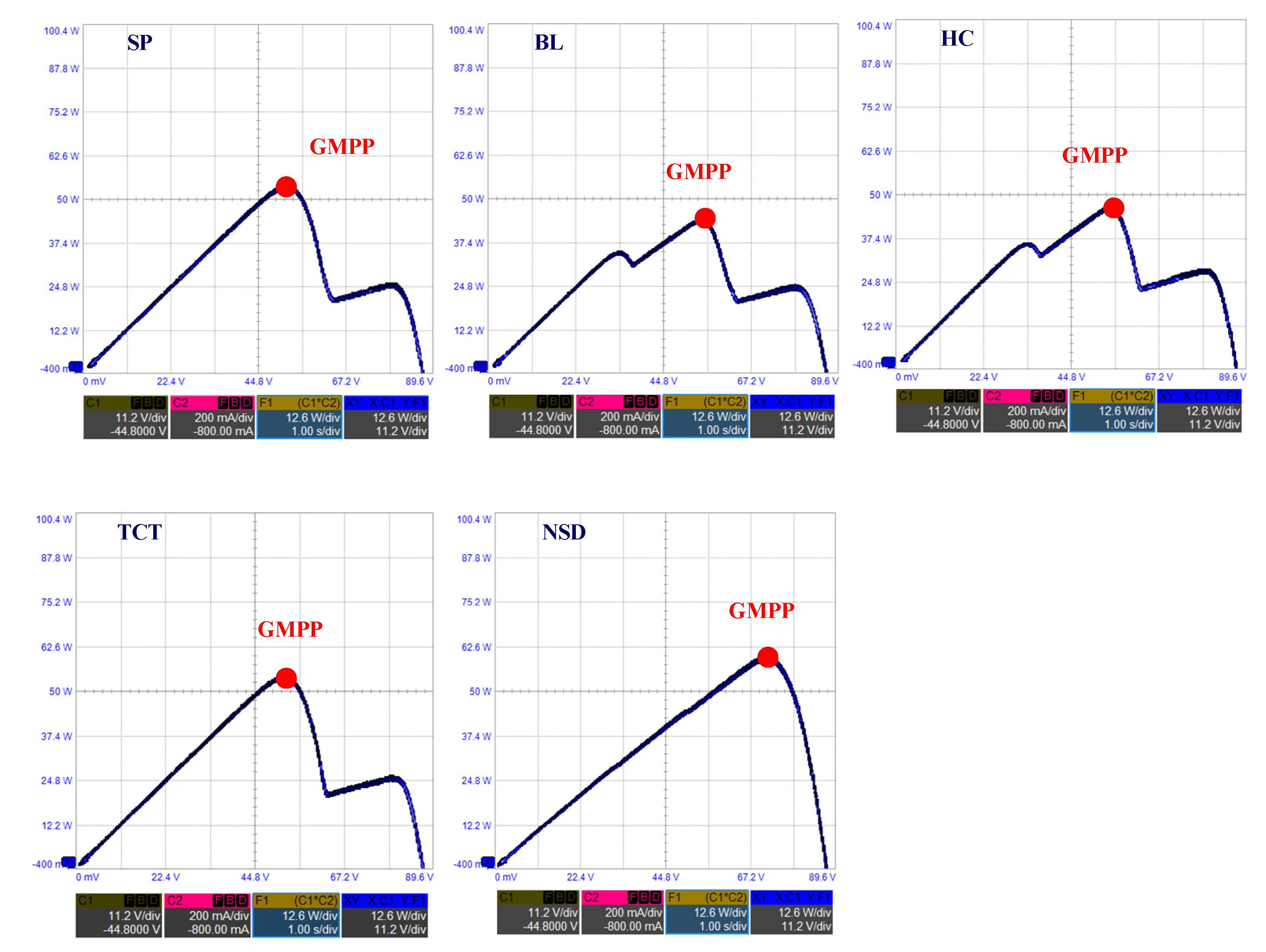

| Connection | Output Voltage | Output Current | Output Power |
|---|---|---|---|
| SP | |||
| TCT | |||
| BL | |||
| HC |
| Shade Cases | VOC (V) | ISC (A) | No. of Peaks | PM (W) | VM (V) | IM (A) |
|---|---|---|---|---|---|---|
| Case I | 217.80 | 47.16 | 1 | 7665.80 | 174.00 | 44.00 |
| Case II | 217.80 | 43.49 | 2 | 4654.30 | 115.15 | 40.42 |
| Case III | 217.80 | 38.64 | 2 | 5655.20 | 174.98 | 32.31 |
| Case IV | 217.80 | 47.15 | 4 | 4711.90 | 115.76 | 44.00 |
| Case V | 217.80 | 45.23 | 5 | 5005.40 | 160.34 | 31.21 |
| Case VI | 216.31 | 44.81 | 3 | 5818.10 | 153.06 | 38.01 |
| Case VII | 214.91 | 43.49 | 4 | 4496.00 | 123.36 | 36.45 |
| Case VIII | 213.54 | 37.49 | 6 | 3309.10 | 115.42 | 28.67 |
| Case IX | 216.81 | 47.16 | 4 | 6068.50 | 175.65 | 34.55 |
| Case X | 215.89 | 44.80 | 5 | 5768.50 | 164.53 | 35.06 |
| Shade Cases | VOC (V) | ISC (A) | No. of Peaks | PM (W) | VM (V) | IM (A) |
|---|---|---|---|---|---|---|
| Case I | 217.70 | 47.16 | 1 | 7665.80 | 174.00 | 44.00 |
| Case II | 215.41 | 47.16 | 2 | 5039.80 | 114.48 | 44.02 |
| Case III | 215.76 | 42.42 | 3 | 6001.20 | 179.43 | 33.45 |
| Case IV | 215.90 | 44.74 | 4 | 6028.20 | 180.12 | 33.47 |
| Case V | 215.30 | 47.14 | 5 | 4627.30 | 189.10 | 27.74 |
| Case VI | 216.48 | 44.80 | 3 | 5833.80 | 147.02 | 39.68 |
| Case VII | 215.09 | 47.15 | 4 | 4807.50 | 116.94 | 41.11 |
| Case VIII | 214.02 | 42.44 | 4 | 4172.10 | 118.73 | 35.14 |
| Case IX | 216.95 | 47.15 | 3 | 6563.30 | 181.91 | 36.08 |
| Case X | 216.01 | 44.78 | 4 | 6093.50 | 180.53 | 33.75 |
| Shade Cases | VOC (V) | ISC (A) | No. of Peaks | PM (W) | VM (V) | IM (A) |
|---|---|---|---|---|---|---|
| Case I | 217.00 | 47.16 | 1 | 7665.80 | 174.00 | 44.05 |
| Case II | 215.36 | 47.16 | 2 | 5039.80 | 114.48 | 44.02 |
| Case III | 215.73 | 42.43 | 3 | 5849.50 | 178.21 | 32.82 |
| Case IV | 216.03 | 44.79 | 3 | 5749.20 | 146.56 | 41.22 |
| Case V | 216.30 | 47.15 | 6 | 5036.20 | 184.84 | 27.24 |
| Case VI | 216.40 | 44.80 | 3 | 5706.00 | 148.28 | 38.48 |
| Case VII | 215.01 | 47.15 | 4 | 4702.90 | 117.56 | 40.00 |
| Case VIII | 213.57 | 39.29 | 3 | 4033.20 | 115.99 | 34.77 |
| Case IX | 216.90 | 47.15 | 4 | 6300.60 | 179.86 | 35.03 |
| Case X | 215.97 | 44.79 | 3 | 5862.10 | 178.79 | 32.79 |
| Shade Cases | VOC (V) | ISC (A) | No. of Peaks | PM (W) | VM (V) | IM (A) |
|---|---|---|---|---|---|---|
| Case I | 217.78 | 47.16 | 1 | 7665.80 | 174.00 | 44.00 |
| Case II | 215.33 | 47.16 | 2 | 5039.80 | 114.48 | 44.00 |
| Case III | 215.75 | 42.43 | 4 | 5913.70 | 179.34 | 32.97 |
| Case IV | 215.63 | 44.79 | 2 | 5674.10 | 146.28 | 38.78 |
| Case V | 216.40 | 47.15 | 6 | 5102.40 | 185.66 | 27.48 |
| Case VI | 216.38 | 44.81 | 3 | 5873.30 | 151.80 | 38.69 |
| Case VII | 214.98 | 47.16 | 4 | 4797.10 | 119.08 | 40.29 |
| Case VIII | 213.59 | 39.30 | 3 | 4042.00 | 116.37 | 34.74 |
| Case IX | 216.90 | 47.16 | 2 | 6320.40 | 179.78 | 35.16 |
| Case X | 216.04 | 47.14 | 5 | 5915.20 | 179.48 | 32.96 |
| Shade Cases | VOC (V) | ISC (A) | No. of Peaks | PM (W) | VM (V) | IM (A) |
|---|---|---|---|---|---|---|
| Case I | 217.79 | 47.17 | 1 | 7665.80 | 174.00 | 44.06 |
| Case II | 215.79 | 40.86 | 1 | 6234.00 | 175.95 | 35.43 |
| Case III | 215.79 | 40.86 | 1 | 6234.00 | 175.95 | 35.43 |
| Case IV | 215.94 | 44.75 | 3 | 6211.00 | 177.56 | 34.98 |
| Case V | 216.04 | 44.75 | 4 | 6303.20 | 177.23 | 35.56 |
| Case VI | 216.54 | 44.78 | 3 | 6645.70 | 177.48 | 37.44 |
| Case VII | 215.54 | 39.25 | 1 | 6132.90 | 174.90 | 35.07 |
| Case VIII | 213.98 | 34.57 | 3 | 5160.20 | 176.34 | 29.26 |
| Case IX | 216.97 | 47.10 | 2 | 6952.80 | 176.76 | 39.34 |
| Case X | 216.04 | 43.18 | 2 | 6350.60 | 177.09 | 35.86 |
Publisher’s Note: MDPI stays neutral with regard to jurisdictional claims in published maps and institutional affiliations. |
© 2022 by the authors. Licensee MDPI, Basel, Switzerland. This article is an open access article distributed under the terms and conditions of the Creative Commons Attribution (CC BY) license (https://creativecommons.org/licenses/by/4.0/).
Share and Cite
Chavan, V.C.; Mikkili, S.; Senjyu, T. Hardware Implementation of Novel Shade Dispersion PV Reconfiguration Technique to Enhance Maximum Power under Partial Shading Conditions. Energies 2022, 15, 3515. https://doi.org/10.3390/en15103515
Chavan VC, Mikkili S, Senjyu T. Hardware Implementation of Novel Shade Dispersion PV Reconfiguration Technique to Enhance Maximum Power under Partial Shading Conditions. Energies. 2022; 15(10):3515. https://doi.org/10.3390/en15103515
Chicago/Turabian StyleChavan, Vinaya Chandrakant, Suresh Mikkili, and Tomonobu Senjyu. 2022. "Hardware Implementation of Novel Shade Dispersion PV Reconfiguration Technique to Enhance Maximum Power under Partial Shading Conditions" Energies 15, no. 10: 3515. https://doi.org/10.3390/en15103515
APA StyleChavan, V. C., Mikkili, S., & Senjyu, T. (2022). Hardware Implementation of Novel Shade Dispersion PV Reconfiguration Technique to Enhance Maximum Power under Partial Shading Conditions. Energies, 15(10), 3515. https://doi.org/10.3390/en15103515







